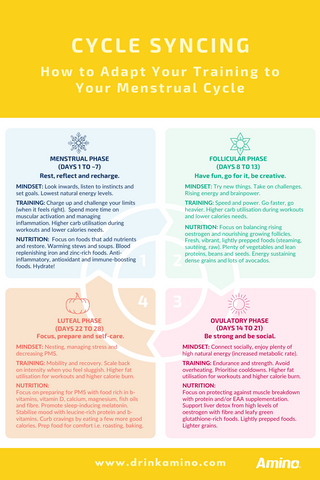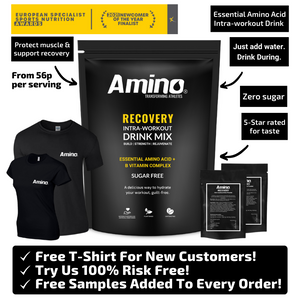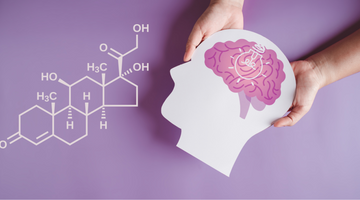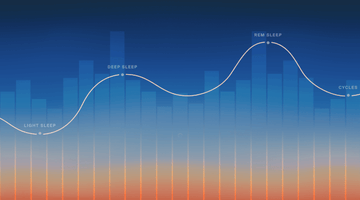“WOMEN ARE NOT SMALL MEN, SO WE SHOULDN’T TRAIN LIKE THEM!”
Stacy Sims, PhD, Physiology Of The Female Athlete, Author Of ROAR.
WHY IS UNDERSTANDING YOUR CYCLE SO IMPORTANT FOR TRAINING?
As a woman, have you ever wondered why you smash a HIIT set one week, then struggle through it the next?
Where you are in your menstrual cycle could have something to do with it. Learning to be aware of your cycle while you train can help you manage stress, boost immunity, understand your metabolism and improve your performance, leaving you feeling fitter, stronger and faster.
As the leading global expert on female-athlete physiology Stacy Sims PhD, says: "It's your physiology, not your fitness.”
“Take mid-distance runner Jessica Judd: In 2018, she discovered that her 3000m time could vary by as much as 15 secs depending on what stage she was at in her menstrual cycle.” That's the difference between first and last place!
Leveraging the hormonal benefits of each stage of the menstrual cycle allows you to adapt your training activities to better suit your energy levels.
You may have noticed that immediately following your period, you start to feel a surge of energy. Suddenly that spinning class seems pretty appealing. Or halfway through your cycle, you’re feeling especially confident and your social calendar is jam-packed. These patterns aren’t random. Your hormones shift throughout your menstrual cycle, causing you to feel and act differently depending on the time of the month. So it figures that adjusting your behaviour and training to support your body as it navigates these changes could help you feel your best.

In this article, we summarise the information provided by leading nutritionist Alisa Vitti (creator of the Cycle Syncing concept) in her book Woman Code along with the sports performance research of Dr Stacy Sims, an exercise physiologist, nutrition scientist and author of the book ROAR.
WHAT IS CYCLE SYNCING?
Cycle syncing is the practice of eating, exercising and aligning with the different phases of your monthly menstrual cycle. That way, you give your body the support it needs, rather than pushing it to perform at the same high level at all times.
At first, something like this might seem a little woo-woo or new agey, but it actually makes a lot of sense. Research shows that fluctuating female sex hormones — primarily oestrogen and progesterone — during a woman’s menstrual cycle influence her mood, energy levels, attractiveness, pain tolerance, and the types of foods she wants to eat. Some studies suggest that switching up what you eat and how you exercise during the different phases could even help you manage and lose weight.
IS CYCLE SYNCING RIGHT FOR ME?
The short answer is yes. Every woman can benefit from a better understanding of her cycle. However, depending on your goals and lifestyle, the impact and your approach to cycle syncing will very much depend on your personal situation. A competitive athlete would need to take a more specific approach than that of someone who is training to stay actively healthy.
Women have a long history of being conditioned to think they should be like men and the same all the time – active, productive and ready for intimacy at any point during their cycle. The natural fluctuations experienced during their cycles are often seen as a hindrance that they feel self-conscious about and an obstacle to overcome.
So if you take anything away from this topic we want it to be a better connection with your body. Positively accept that you are cyclical by nature so you can harness the power of your cycles. And when your cycle is all out of whack, use the knowledge of your cycle as a tool to rebalance.
CAN YOU CYCLE SYNC IF YOU’RE ON HORMONAL CONTRACEPTION?
If you’re on hormonal contraception, like the birth control pill, you’re not going to experience the same phases as you would on a natural cycle.
Hormonal contraceptives release synthetic forms of oestrogen and progesterone that alter your natural hormone levels — this stops your body ovulating. You can still monitor how you feel throughout the month and make adjustments, but your symptoms won’t always mirror those felt during a natural cycle.
HOW TO GET STARTED
“The first step is to get in touch with your body and bring awareness to where you are in your cycle or ‘ your inner season’”, says Clare Rodea-Ryan, a women's wellness consultant. It’s especially important if you’ve recently come off hormonal birth control, which puts you out of touch with your natural rhythms.
“Start with observation, then begin to track your cycle,” says Clare. “Take note of what foods you’re craving or what your energy levels are like at different times of the month.”
You’ll also want to figure out the length of your menstrual cycle. You can do this by using a period-tracking app like MyFLO, CLUE, Eve or simply mark the first day of your period on a calendar, and count the days from there until your next period begins. Do this for a couple of months and you should get a good idea of the length of your cycle.
Related: Listen to Clare chat with Amino Founder/CEO Simon about Why is it essential to know how the menstrual cycle affects women day in day out?
HOW TO ADAPT YOUR TRAINING TO YOUR CYCLE PHASES
While everybody is different and cycle lengths can vary, science is still a great guide for our fitness choices.
There are four phases of the menstrual cycle: menstruation, follicular, ovulatory and luteal. By smartly adapting your mindset, nutrition and training across the 4 cycle phases, you can manage and even master your symptoms so they don’t derail your fitness goals.
With the help of Stacy Sims’s research, we’ve outlined some generalised ways in which you can adapt your mindset, training and nutrition to the phases of your cycle.
Take Day 1 of your period as the kick-off point to start cycle syncing and get the best out of your workouts.

MENSTRUAL PHASE (DAYS 1 TO 7) | Rest, reflect and recharge.
We’re all familiar with this phase! It begins as soon as you start to bleed, which signals the beginning of a new cycle. Menstruation is sometimes referred to as your “inner winter” or the “new moon” phase of your cycle.
When your cycle is functioning optimally, the length of this phase typically lasts 3-7 days. If you don’t get pregnant that month, your oestrogen and progesterone levels drop to their lowest levels and trigger menstruation.
As you move through this phase you’ll start to feel more energised and motivated. Some women feel this as soon as their period starts.
Your hormone levels are at their lowest during this time – and most like a “man” - so you may be able to perform at your best during menstruation. One study conducted on swimmers found that women clocked their fastest times during menstruation and their slowest during the days leading up to their period. You know your body best, so do what feels comfortable for you.
YOUR MINDSET
During your period, both sides of your brain sync up and communicate exceptionally well, which means your intuition can be heightened and you’ll naturally be drawn inward.
If you can, take some time to slow down and tune in as this is a good time for some serious self-reflection and goal setting. Perhaps try journaling or creating a vision board of your goals for the coming month or just reflecting on stuff that’s bothering you. This phase is much like how we feel during cold, blustery winter days; we want to go inward, get quiet, rest, reflect and rejuvenate.
YOUR NUTRITION
Focus on warm and satisfying foods that are rich in vitamins and minerals (iron, zinc) to help compensate for the loss of blood and drop in energy. Think hearty stews, chilli, soups, lightly cooked dark leafy greens, sea veggies and grass-fed red meat. Insulin sensitivity is increased during menstruation so low-glycemic fruits like berries are great for blood sugar balance.
Manage menstrual symptoms - headaches, cramps, bloating.Increase anti-inflammatory foods rich in vitamin D, calcium, fish oils (omega-3) and B-vitamins. Look for nuts, seeds, berries, plain yoghurt, krill oil, olive oil and wild salmon. Certain herbs and spices have anti-inflammatory properties like turmeric, ginger, cinnamon, cayenne, cardamom, cumin, garlic, parsley.
Support your immune system while your white cell count is lower during this phase.
For antioxidants, eat more nuts, seeds, berries, tart cherry juice and kiwis. For vitamin C & zinc, choose citrus fruits, bell peppers, broccoli, blackcurrants. Your body makes its own antioxidants, of which Glutathione is one. The amino acid L-Glutamine is a core component of this antioxidant, so supplementing can be a great way to boost your antioxidants. Most importantly, sleep! Try and regulate your sleep schedule to protect your immune system.
Related: How to stop a cold in its tracks
Compensate for blood loss.Re-mineralise with iron and zinc-rich foods with a source of vitamin C. Kale, spinach, chard, collard greens, broccoli, mushrooms, beetroot, bell peppers, lentils, pinto beans, kidney beans, chickpeas, citrus fruits, strawberries, cherries, pineapple, mango, papaya. Hydration is super important so drink 2 litres of water or more per day. Consider adding hydration salts to your water and drinking non-caffeinated teas.
Fuel your workouts.During this phase, your body uses your carbohydrates (glycogen) stores more efficiently, which is great if you want to push for heavier lifts or more intensity during your training. Your natural calorie need is also lower due to your basal metabolic rate (BMR) being at its lowest. That said, to ensure performance and recovery is optimal, you might need to fuel high-intensity training and longer endurance (1hr+) workouts with carbohydrates.
YOUR TRAINING
Your energy is at its lowest at the start of your period, so honour your body’s needs by carving out time for some self-care and sleep. For a few days aim for gentle yoga, pilates and walking. When you start to feel your energy return you can turn it up again as this can be a great phase to gain maximum benefit from HIIT and strength training.
- Moderate-intensity workouts and strength training.
- Relieve tension and symptoms by doing an activity that makes you feel good.
- Try muscle activation workouts in preparation for the next phase.
- Recovery is especially important during this phase due to increases in inflammation.
Related: Sleep - It may help you build muscle and burn fat
FOLLICULAR PHASE (DAYS 8 TO 13) | Have fun, go for it, be creative.
The follicular phase is the second of your cycle and begins immediately after menstruation. This is where your body moves into “inner spring”, and the “waxing moon”. This phase typically lasts about 7-10 days.
Your hormones begin to rise as your body prepares for ovulation. But your hormones aren’t the only thing that increases during this time; so does your energy and mental alertness! This is a great time to tackle new projects, take on mentally challenging tasks, embrace new experiences and get outside your comfort zone.
YOUR MINDSET
Your brain is sharp and you’re ready to problem solve. You’re also feeling social and ready to mingle. This is the prime time to think big and plot world domination. If you’ve been procrastinating on your next goal now is the time to take action. Try new activities or skills — join that running club or take an acro yoga class.
YOUR NUTRITION
Fill your plate with light, energising foods that help to metabolise oestrogen and nourish the growing follicles. Light protein, like pasture-raised eggs and wild-caught fish, is ideal. Fresh raw salads, oats with nut butter and flaxseed are also perfect.
Eat more insoluble fibre, dark leafy greens and cruciferous vegetables that will help your metabolism and flush oestrogen out of the body.
Nourish growing follicles.
Look for foods high in vitamin E and healthy fats like avocado, spinach, sunflower seeds, almonds and trout.
Aid recovery and protect against injury
Collagen synthesis and neuromuscular control can be reduced during the latter part of this phase so, to aid recovery, try protein and complex carbohydrates after your workout sessions. Eggs, cottage cheese, nut butter, lean chicken, wild salmon, pulses, fruit, whole grains and oats are perfect. Add sources of collagen and vitamin C to help with muscle, tendon and ligament recovery too. Choose wild-caught fish, chicken, egg whites, citrus fruits, bell peppers, broccoli, blackcurrants and kiwis.
Fuel your workouts.
While your blood sugar levels are more stable you might notice a reduced appetite. Prior to ovulation your body is still efficiently utilising your carbohydrate stores but you might need to fuel high-intensity efforts and longer endurance (1hr+) workouts with carbohydrates (before and after) to ensure performance and recovery are optimal.
YOUR TRAINING
It's all about speed and power. Go for high-intensity workouts and heavyweight training as testosterone and oestrogen rise. Basically, any challenging exercise will feel revitalising.
Or, try something you’ve never done before. Look to develop new skills and learn new techniques. HIIT classes, all-out efforts, hills or sprints should feel invigorating. You could increase your deadlift by one rep and beat your PB. Ultimately, look to move your body in fun and energising ways.
- Your body's better at adapting to your training during this phase so go for it.
- Warm-up before you hit it hard because rising progesterone levels may increase injury risk.
- Your strength peaks but don’t forget to recover properly.
OVULATORY PHASE (DAYS 14 TO 21) | Be strong and be social.
Your “inner summer”. This phase is all about being social and getting shiz done! This tends to be when your confidence is high, and you’re more outspoken and bolder than usual. This phase also syncs up with the energy of a “full moon”, which is about birthing new projects into the world.
This is when your body prepares for ovulation, releasing an egg. As your oestrogen continues to rise, your testosterone peaks and then immediately falls right around ovulation. During this phase, take advantage of your powerful feminine nature! Now is the time to step into your strength, make bold decisions and create something new.
YOUR MINDSET
This is the time to have that difficult conversation you’ve been avoiding. It’s ideal for connecting with others, public speaking and starting new things.
YOUR NUTRITION
During this time your oestrogen will be high, so you’ll want to eat foods that support your liver and are anti-inflammatory. Also reach for magnesium-rich foods like spinach and dark chocolate, because a good supply of magnesium helps to balance oestrogen and progesterone.
Eat whole foods like fresh high-fibre fruit and vegetables plus lighter proteins. Go hard on the greens i.e. cruciferous vegetables like cauliflower, broccoli and bok choy. They’re rich in glutathione, an antioxidant that can help your body flush out toxins, including excess oestrogen.
Stabilise cravings and reduce energy dips with healthy fats and snacks. When your blood sugar levels are unstable, try oily fish, unsalted nuts, mixed seeds, avocados and nut butter. Complex carbs like oats, quinoa, lentils and low GI berries are also great.
Preempt increased sweat rates as body temperature rises by 0.3oC.
Stay hydrated and consider adding hydration salts to your water.
Load up again on anti-inflammatory foods rich in vitamin D, calcium, omega-3 and B-vitamins. Look for nuts, seeds, berries, plain yoghurt, krill oil, olive oil and wild salmon. Certain herbs and spices have anti-inflammatory properties like turmeric, ginger, cinnamon, cayenne, cardamom, cumin, garlic, parsley. For antioxidants, eat more nuts, seeds, berries, tart cherry juice, kiwis. For vitamin C & zinc choose citrus fruits, bell peppers, broccoli, blackcurrants. For magnesium, choose things like spinach, dark chocolate, seeds (pumpkin), almonds, cashews, or a supplement.
Related: Why should everyone take Magnesium and Vitamin D
Take an EAA supplement like Amino RECOVERY during/after your workout.
Fuel your workouts.
Post ovulation, your body becomes better at using fat for energy, which is great for sustaining any steady-state aerobic or longer endurance training. Your BMR (basal metabolic rate) climbs during the luteal phase, peaking around halfway through. This means the minimum number of calories your body needs to function will be higher, and you’ll be burning more calories through the process of digestion too.
For higher intensity efforts, your body requires more complex carbohydrates and B-vitamins to perform so add a source of carbohydrate and eat a little more of everything.
YOUR TRAINING
This is a great time for endurance and strength because your energy is at an all-time high. Fat will more readily be used as fuel at this time, so incorporate endurance or LISS (Low-Intensity Steady State) training, also known as cardiovascular or aerobic exercise. Focus on resistance exercises too. Longer easy runs or hilly hikes are great if you are running. Use moderate loads if you are training.
In order to ensure you’re using your fat-burning energy system rather than your glycogen-fuelled systems, keep cardio sessions at a light, conversational pace. You should be slightly out of breath, but able to go for quite a while and still talk in mostly unbroken sentences.
Related: What are amino acids and why do you need them
LUTEAL PHASE (DAYS 22 TO 28) | Focus, prepare and self-care.
The final phase of your cycle (before it starts again), is your “inner autumn”, the waning moon. Like the autumn season, now is the time to prepare and focus on ‘harvesting’ all the work did in spring and summer, and start to slow your body down.
During this phase, both progesterone and oestrogen levels are high. Once progesterone stops being produced, it signals the start of your next period. This phase tends to be the longest in your cycle and can last for about 10-14 days. Oftentimes, during the second half of this phase (days 7-14), you’ll find that your energy begins to drop, and those familiar PMS symptoms start to kick in.
Pay attention to your body, and be sure to give it the gentleness and care it needs if you find yourself getting irritable, bloated, having mood swings, or experiencing intense cravings.
YOUR MINDSET
Your attention is starting to turn inward and you’re feeling a desire to nest and spend time at home and stick with the familiar. This is a good time to take care of administrative tasks. You’ll be more detail-oriented and will likely feel called to organise and clean all of the things!
YOUR NUTRITION
This is the time for grounding and warm foods like soups, baked protein and roasted root vegetables, such as sweet potatoes, carrots and squash. Continue eating pasture-raised meat and healthy fats. Foods like kale and broccoli are essential in keeping neurotransmitters balanced and warding off PMS symptoms. Plus, eat foods that aid serotonin production and are rich in magnesium.
Fibre, complex carbohydrates and protein. If your sugar cravings are strong, be sure to eat balanced meals with additional servings of carbs like quinoa, brown rice and buckwheat.
Stabilise mood
Eat leucine-rich protein and increase your intake of tryptophan-rich foods such as seeds, eggs, turkey, and cottage cheese as these may help boost the production of serotonin.
Plan to manage premenstrual symptoms (PMS) by targeting vitamin D, calcium, magnesium, omega-3 and B vitamins.
Continue with anti-inflammatory and antioxidant-rich foods such as tuna, mackerel, eggs, walnuts, flaxseeds, chia seeds, organic blackberries, raspberries, strawberries, and blueberries. Magnesium from spinach, dark chocolate, pumpkin seeds, almonds, cashews – or try a supplement. Hydrate and avoid caffeine.
Protect against sleep disruption during this phase.
Promote sleep with sleep-inducing melatonin foods such as tart cherry, bananas, oats, walnuts.
Fuel your workouts.
At the beginning of this phase, your body will still have higher fat utilisation for workout energy but it will shift back to carbohydrates towards the end. For higher intensity efforts, your body still needs complex carbohydrates and B-vitamins to sustain energy and your performance (depending on the activity).
YOUR TRAINING
You’ll want to start winding down your exercise during this phase. Your energy will remain high during the start of this phase, so you could keep with the high-intensity workouts until your energy starts to decrease, (usually during the last 5 days), when you should move your focus to more calming, lower-resistance workouts, such as yoga, pilates or walking. Prioritise flexibility and technique, working on your form. Individualise your exercise for how you feel that day and honour what your body needs.
CYCLE SYNC YOUR RUNNING
Breezing through a run one day, and then struggling through it the next might have something to do with where you are in your menstrual cycle. Just like training, you can adapt your running routine to the three main phases of your cycle.
In the early phases, run faster, recover better and feel more energetic. During the third phase (summer), go longer. Or if you’re feeling bulletproof, nail that PB. If, in the end phase, you’re feeling flat or experiencing PMS symptoms (headaches, bloating, fatigue) go for easy hikes, jogs and work on your form.

OTHER RESOURCES
Nike Training App - They have a cycle syncing workout collection.
FitrWoman App - Track Your Period & Train Smarter
Stacy Sims @drstacysims
> Why Women Are Not Small Men with Dr Stacy Sims - Mind Muscle Project Podcast
> Stacy’s TED Talk
> Stacy’s Book ROAR
Clare Rodea-Ryan - Yoga Teacher, Women's Wellness & Empowerment Mentor
ENJOYED THIS ARTICLE?
REFERENCES
Gretchen, et al. Menstrual cycle phase and oral contraceptive effects on triglyceride mobilization during exercise. J Appl Physiol 2004;97: 302-309.
Davidson, et al. Impact of the menstrual cycle on determinants of energy balance: a putative role in weight loss attempts. International Journal of Obesity. 2007;31:1777-1785
D’eon et al. The Roles of Estrogen and Progesterone in Regulating Carbohydrate and Fat Utilization at Rest and during Exercise. Journal women’s health and gender based medicine 2002;11(3):225-237.
Nakamura et al. Hormonal Responses to Resistance Exercise during Different Menstrual Cycle States. Medicine & Science in Sports & Exercise. 2011 Jun;43(6):967-73
Oosthuyse & Bosch. The Effect of the Menstrual Cycle on Exercise Metabolism. Sports Medicine. 2010;4(3):207-227.
Wojtys, Edward M., et al. “The effect of the menstrual cycle on anterior cruciate ligament injuries in women as determined by hormone levels.” The American Journal of Sports Medicine2 (2002): 182-188.
Sarwar, R., B. Beltran Niclos, and O. M. Rutherford. “Changes in muscle strength, relaxation rate and fatiguability during the human menstrual cycle.” The Journal of physiologyPt 1 (1996): 267.






